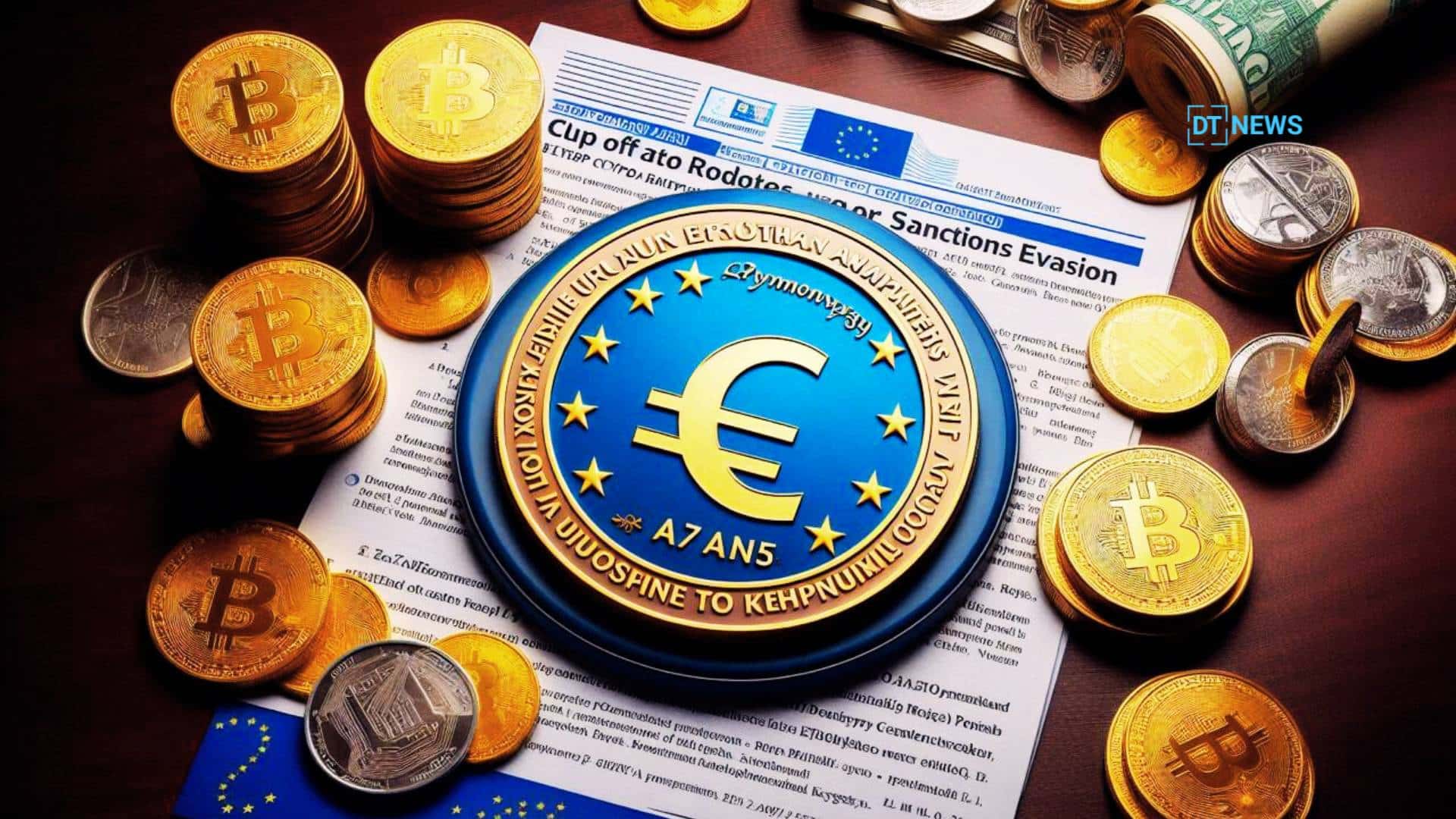Reports have emerged that the European Union is moving to sanction A7A5 stablecoin , a ruble-backed stablecoin issued by Russia, to cut off crypto routes used for sanctions evasion. The token, issued by A7 and Promsvyazbank, has reportedly been used to funnel ruble funds into crypto markets via Kyrgyzstan and other jurisdictions.
Available data shows that these flows only account for about 2.37 % of European Bitcoin trading volume. While this will impose compliance burdens on EU crypto companies, will it disrupt core Bitcoin liquidity in the region?
A7A5 Stablecoin and Its Sanctioned Backers
A7A5 was launched in early 2025 by A7, a payments company controlled by Moldovan fugitive banker Ilan Shor, and Russia’s Promsvyazbank (PSB). PSB had been sanctioned by the EU, UK and US for assisting in financial evasion and defense sector financing.
The A7A5 Stablecoin is issued on Ethereum and Tron, with the network design involving Kyrgyzstan-based entities such as Grinex, which many consider a successor to the previously sanctioned exchange Garantex.

Elliptic data as of September 26 shows 41.6 billion A7A5 tokens in circulation, valued at roughly USD 496 million, and a cumulative transaction volume of USD 68 billion.
So despite sanctions and scrutiny, A7A5 had grown big in a short time.
Also read: EU Sanctions Garantex—A Crackdown on Russian Crypto?
How A7A5 Routes Ruble to Crypto
A7A5 Stablecoin is a rail for converting rubles into cryptocurrencies via several ways.
The main path is users exchanging rubles into A7A5 within A7’s system or through Old Vector operations. Then via Kyrgyzstan-registered exchanges like Grinex, they swap A7A5 into dollar-pegged stablecoins like USDT.
Another way is via over-the-counter (OTC) and peer-to-peer markets directly converting rubles to USDT inside Russia, often using Tron services.
Regional transit hubs such as Kyrgyzstan and Turkey serve as intermediaries. Turkey has recently capped stablecoin transfers to $3,000 daily and $50,000 monthly to stop routing through its territory.The flow shows how sanctioned entities try to stay connected to global crypto markets even under restrictions.
EU’s Sanctions on A7A5 Stablecoin
According to multiple reports, the European Union is planning to sanction A7A5. The sanctions would ban EU-based entities from dealing directly or indirectly with A7A5.
Banks in Russia, Belarus and Central Asia believed to facilitate crypto transactions for sanctioned actors would also be targeted.
EU sanctions proxy documents cited by Bloomberg say the block will limit A7A5 usage in the bloc.
In effect, these rules will isolate A7A5 as a ruble-only channel and force logout from regulated crypto markets.
Volume, Exposure, and European Bitcoin Liquidity
Though A7A5 Stablecoin is active, its impact on European Bitcoin liquidity is minimal. EU-regulated venues saw $7.5 trillion in Bitcoin trading volume in H1 2025 (regulated on-chain and OTC combined) per ESMA.
Elliptic’s data: total volume $68B for A7A5; and 6% Europe-directed flow estimate shows A7A5’s net European flows are 0.071 % of total EU Bitcoin volume.
But factoring in untracked OTC, P2P and other routes, conservative estimates put ruble-to-Bitcoin exposure at 2.37 % of EU trading volume.
So while A7A5 gets attention, its impact on the broader BTC/EUR order books seems small.
Also read: Russia Moves Toward Crypto Regulation Following U.S. Initiatives
What the Sanctions Mean for Markets
The sanctions against A7A5 Stablecoin are symbolic and regulatory. They reveal deeper coordination between the EU and US and UK, targeting crypto infrastructure used by sanctioned actors.

EU-based VASPs will need to beef up their compliance systems, screen for A7A5 interactions, and cut ties. Given the dominance of BTC/EUR pairs on regulated European exchanges, mainstream Bitcoin trading seems insulated from risk.
In short, the sanctions make it harder for certain on-ramp strategies but might not choke core European crypto liquidity.
Conclusion
Based on the latest research, the EU is sanctioning A7A5, a ruble stablecoin reportedly used to pump capital into crypto markets, but analyst say it’s a regulatory move to disrupt sanctioned rails not core liquidity.
Though A7A5 has seen tens of billions in activity, but its flows into Europe are a small fraction of Bitcoin trading volume. What the sanctions really do is raise the compliance bar and close one escape valve, not remake Europe’s crypto markets overnight.
For in-depth analysis and the latest trends in the crypto space, our platform offers expert content regularly.
Summary
EU is sanctioning ruble stablecoin A7A5, to cut a ruble-to-crypto route. Data shows those flows are a small part (2.37 %) of Bitcoin trading in Europe and may not entirely be disruptive.
Glossary
A7A5 – Ruble backed stablecoin used in crypto flows related to Russian entities.
On-ramp – Fiat (e.g. ruble) to crypto.
VASPs – Virtual Asset Service Providers (exchanges, custodians in crypto).
BTC/EUR – Bitcoin trading pair in euros.
OTC / P2P – Off-exchange / peer-to-peer.
Sanctions evasion – Using financial systems to bypass restrictions on individuals or entities.
Frequently Asked Questions About Ruble-backed A7A5 Stablecoin Sanction
Who issues A7A5 Stablecoin and why is it sanctioned?
A7A5 is issued by A7 and Promsvyaz bank, connected to sanctioned Russian entities. It’s targeted because of its role in reportedly funnelling capital into crypto markets under sanctions.
How many A7A5 Stablecoins are in circulation?
As of September 26, sources report 41.6 billion tokens in circulation, worth about USD 496 million.
Will these sanctions collapse European BTC liquidity?
No; A7A5 routes are a small part of EU Bitcoin volume. Core liquidity is spread across established BTC/EUR pairs.
What do EU-based crypto companies need to do?
They will need to screen for A7A5 exposure and stop prohibited activities under new rules.



















































































































